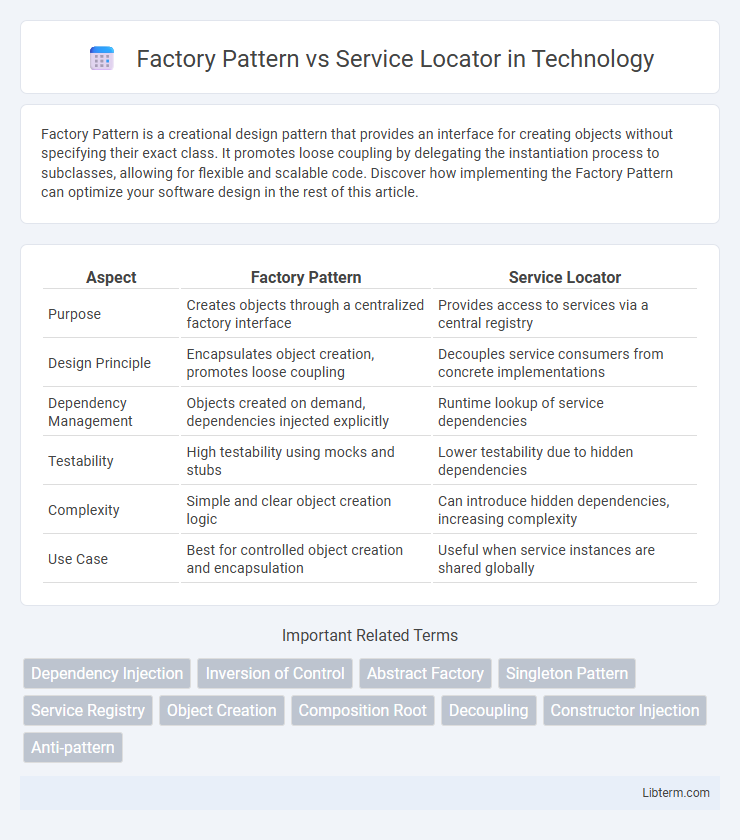Factory Pattern is a creational design pattern that provides an interface for creating objects without specifying their exact class. It promotes loose coupling by delegating the instantiation process to subclasses, allowing for flexible and scalable code. Discover how implementing the Factory Pattern can optimize your software design in the rest of this article.
Table of Comparison
| Aspect | Factory Pattern | Service Locator |
|---|---|---|
| Purpose | Creates objects through a centralized factory interface | Provides access to services via a central registry |
| Design Principle | Encapsulates object creation, promotes loose coupling | Decouples service consumers from concrete implementations |
| Dependency Management | Objects created on demand, dependencies injected explicitly | Runtime lookup of service dependencies |
| Testability | High testability using mocks and stubs | Lower testability due to hidden dependencies |
| Complexity | Simple and clear object creation logic | Can introduce hidden dependencies, increasing complexity |
| Use Case | Best for controlled object creation and encapsulation | Useful when service instances are shared globally |
Introduction to Factory Pattern and Service Locator
The Factory Pattern centralizes object creation, promoting loose coupling by delegating instantiation logic to factory classes, which enhances code flexibility and testability. The Service Locator pattern simplifies dependency management by providing a centralized registry to retrieve service instances, reducing the need for explicit dependency injection. Both patterns address object creation but differ in control flow and testability implications.
Core Concepts and Definitions
The Factory Pattern centralizes object creation by providing a dedicated method or class to instantiate various related objects without specifying their exact classes, promoting loose coupling and scalability. Service Locator acts as a registry from which clients request service instances, encapsulating the lookup process and simplifying dependency management but potentially hiding dependencies and complicating testing. Both address dependency resolution, with Factory emphasizing controlled creation and Service Locator focusing on flexible service retrieval.
Key Differences Between Factory Pattern and Service Locator
The Factory Pattern centralizes object creation by defining an interface for creating instances, promoting loose coupling through explicit dependency management. The Service Locator pattern provides a registry to retrieve dependencies dynamically, which can obscure class dependencies and hinder testability. Key differences include Factory Pattern's focus on encapsulating instantiation logic versus Service Locator's emphasis on runtime lookup of services, impacting maintainability and code clarity.
When to Use Factory Pattern
Use the Factory Pattern when creating objects involves complex logic or requires selecting among multiple subclasses dynamically at runtime. It is ideal for promoting loose coupling and enhancing code maintainability by encapsulating object creation in a dedicated factory class. This pattern suits scenarios where the exact types of objects to instantiate depend on runtime conditions, avoiding the drawbacks of service locator's hidden dependencies.
When to Use Service Locator
Use the Service Locator pattern when managing complex dependency graphs or when objects require dynamic retrieval of collaborators at runtime without the overhead of constructor injection. It centralizes object creation and access, making it suitable for applications needing flexible and decoupled service resolution. This pattern is particularly effective in legacy systems or frameworks where changing existing object creation processes is impractical.
Pros and Cons of Factory Pattern
The Factory Pattern offers clear advantages such as promoting loose coupling by abstracting object creation, enhancing code maintainability and testability through centralized instantiation logic. It can, however, introduce complexity with multiple factory classes and may lead to over-engineering in simple scenarios. The pattern's structure supports scalability and adherence to SOLID principles, but improper use can result in less flexible code compared to dependency injection solutions like the Service Locator.
Pros and Cons of Service Locator
Service Locator centralizes dependency management by providing a single registry for obtaining services, simplifying object creation and decoupling clients from concrete implementations. However, it can obscure dependencies, making code harder to understand and maintain, while also introducing hidden runtime errors due to lack of compile-time checks. Unlike the Factory Pattern, which promotes explicit dependency injection and greater transparency, Service Locator may lead to tighter coupling and reduced testability because of its implicit control flow.
Impact on Code Maintainability and Testability
The Factory Pattern enhances code maintainability and testability by promoting explicit dependency injection, allowing easy substitution of implementations and clearer object creation logic. Service Locator tends to obscure dependencies, making the codebase harder to understand, maintain, and mock during unit testing. Consequently, the Factory Pattern supports cleaner separation of concerns and simplifies testing setups compared to the Service Locator.
Real-world Examples and Use Cases
The Factory Pattern is commonly used in scenarios like object creation for different types of documents in a word processing application, ensuring each document type is instantiated correctly without exposing the creation logic. In contrast, the Service Locator pattern excels in managing dependencies in large-scale enterprise applications, such as retrieving database connection objects or logging services from a centralized registry. Real-world use cases show the Factory Pattern streamlines polymorphic object creation, while the Service Locator provides flexible service retrieval, especially in modular systems where services might be dynamically replaced or reconfigured.
Choosing the Right Pattern for Your Project
Choosing the right pattern between Factory and Service Locator depends on your project's complexity and maintainability needs. The Factory Pattern excels in creating objects with clear, explicit dependencies, promoting testability and loose coupling. Service Locator offers centralized service management but can obscure dependencies, making it less ideal for large-scale, maintainable applications.
Factory Pattern Infographic

 libterm.com
libterm.com